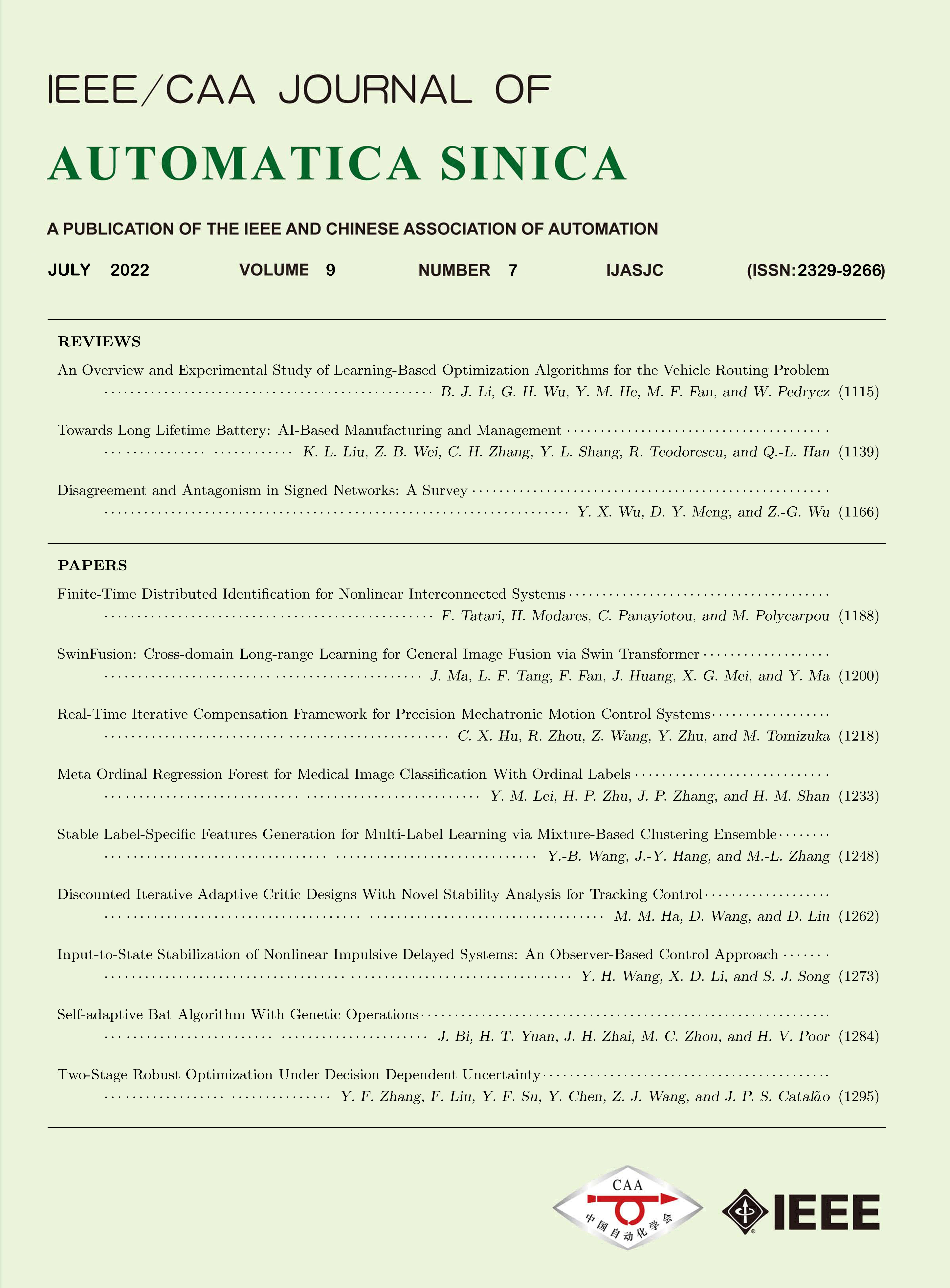 Volume 9
Issue 7
Volume 9
Issue 7
IEEE/CAA Journal of Automatica Sinica
| Citation: | M. Liu, S. B. Li, and L. Jin, “Modeling and analysis of Matthew effect under switching social networks via distributed competition,” IEEE/CAA J. Autom. Sinica, vol. 9, no. 7, pp. 1311–1314, Jul. 2022. doi: 10.1109/JAS.2022.105527 |

| [1] |
R. Farys and T. Wolbring, “Matthew effects in science and the serial diffusion of ideas testing old ideas with new methods,” Quant. Sci. Stud., vol. 2, no. 2, pp. 505–526, Jul. 2021. doi: 10.1162/qss_a_00129
|
| [2] |
K. Drivas and D. Kremmydas, “The Matthew effect of a journal’s ranking,” Res. Policy, vol. 49, no. 2020, p. 103951, May 2020.
|
| [3] |
W. Hong, G. Li, W. Zhang, R. Tang, and Y. Yu, “DropNAS: Grouped operation dropout for differentiable architecture search,” in Proc. Int. Joint Conf. Artif. Intell, Yokohama, Japan, 2020, pp. 2326−2332.
|
| [4] |
M. Ozer and M. Prec, “Dreams and realities of school tracking and vocational education,” Palgrave Commun., vol. 34, Feb. 2020.
|
| [5] |
B. L. Perry, B. Aronson, and B. A. Pescosolido, “Pandemic precarity: COVID-19 is exposing and exacerbating inequalities in the American heartland,” Proc. Natl. Acad. Sci. USA, vol. 118, no. 8. pp. 1–6, 2021.
|
| [6] |
Y. Li, Y. Li, K. Dávid, Z. Liu, Y. Wang, and J. Wang, “Spatio-temporal pattern and driving forces of construction land change in a poverty-stricken county of China and implications for poverty-alleviation-oriented land use policies,” Land Use Pol., vol. 91, no. 2020, p. 104267, Feb. 2020.
|
| [7] |
C. M. Macal, “Agent-based modeling and artificial life,” in Complex Social and Behavioral Systems: Game Theory and Agent-Based Models, New York, USA: Springer, pp. 725−745, Aug. 2020.
|
| [8] |
Y. Ju, D. Ding, X. He, Q.-L. Han, and G. Wei, “Consensus control of multi-agent systems using fault-estimation-in-the-loop: Dynamic event-triggered case,” IEEE/CAA J. Autom. Sinica, 2021, DOI 110.1109/JAS.2021.1004386.
|
| [9] |
M. S. Shamil, F. Farheen, N. Ibtehaz, I. M. Khan, and M. S. Rahman, “An agent-based modeling of COVID-19: Validation, analysis, and recommendations,” Cogn. Comput., 2020, DOI 2021.10.1101/2020.07.05.20146977.
|
| [10] |
L. Wang, J. Xi, B. Hou, and G. Liu, “Limited-budget consensus design and analysis for multiagent systems with switching topologies and intermittent communications,” IEEE/CAA J. Autom. Sinica, vol. 8, no. 10, pp. 1724–1736, Oct. 2021. doi: 10.1109/JAS.2021.1004000
|
| [11] |
S. Wang and J. Huang, “Cooperative output regulation of singular multi-agent systems under switching network by standard reduction,” IEEE Trans. Circuits Syst. I-Regul. Pap., vol. 65, no. 4, pp. 1377–1385, Apr. 2018. doi: 10.1109/TCSI.2017.2755686
|
| [12] |
X. Wang and G. Yang, “Fault-tolerant consensus tracking control for linear multiagent systems under switching directed network,” IEEE Trans. Cybern., vol. 50, no. 5, pp. 1921–1930, May 2020. doi: 10.1109/TCYB.2019.2901542
|
| [13] |
D. Ding, Q.-L. Han, Z. Wang, and X. Ge, “Recursive filtering of distributed cyber-physical systems with attack detection,” IEEE Trans. Syst. Man Cybern. -Syst., vol. 51, no. 10, pp. 6466–6476, Oct. 2021. doi: 10.1109/TSMC.2019.2960541
|
| [14] |
L. Jin, X. Zheng, and X. Luo, “Neural dynamics for distributed collaborative control of manipulators with time delays,” IEEE/CAA J. Autom. Sinica, vol. 9, no. 5, pp. 854–863, May 2022.
|
| [15] |
D. Ding, Q.-L. Han, Z. Wang, and X. Ge, “A survey on model-based distributed control and filtering for industrial cyber-physical systems,” IEEE Trans. Ind. Inform., vol. 15, no. 5, pp. 2483–2499, May 2019. doi: 10.1109/TII.2019.2905295
|
| [16] |
R. Freeman, P. Yang, and K. Lynch, “Stability and convergence properties of dynamic average consensus estimators,” in Proc. IEEE Conf. Decis. Control, San Diego, USA, 2006, pp. 338−343.
|
| [17] |
S. Li and Y. Guo, “Distributed consensus filter on directed graphs with switching topologies,” in Proc. Amer. Control Conf., Washington, USA, 2013, pp. 6151−6156.
|
| [18] |
N. Alvarez-Jarquin, A. Loría and J. L. Avila, “Consensus under switching spanning-tree topologies and persistently exciting interconnections,” in Proc. Amer. Control Conf., Milwaukee, USA, 2018, pp. 4578−4583.
|
| [19] |
Y. Qi, L. Jin, X. Luo, Y. Shi, and M. Liu, “Robust k-WTA network generation, analysis, and applications to multiagent coordination,” IEEE Trans. Cybern., 2021, DOI 10.1109/TCYB.2021.3079457.
|
| [20] |
S. Li, M. Zhou, X. Luo, and Z. You, “Distributed winner-take-all in dynamic networks,” IEEE Trans. Autom. Control, vol. 62, no. 2, pp. 577–589, Feb. 2017. doi: 10.1109/TAC.2016.2578645
|
| [21] |
X. Hu and J. Wang, “An improved dual neural network for solving a class of quadratic programming problems and its k-winners-take-all application,” IEEE Trans. Neural Netw. Learn. Syst., vol. 19, no. 12, pp. 2022–2031, Dec. 2008. doi: 10.1109/TNN.2008.2003287
|